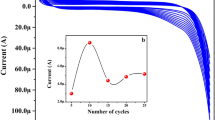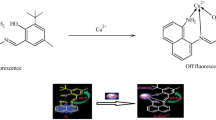Abstract
The pyrogallol red-based Zn2+ complex (PR-Zn2+) between commercially available anionic dye, pyrogallol red (PR), and Zn2+ in the presence of cationic poly(diallyldimethylammonium chloride) (PDADMAC) was applied to the colorimetric recognition of pyrophosphate (PPi) in a pure aqueous solution under physiological pH. Upon the gradual addition of PPi to PR-Zn2+, the distinct color change from blue to pink could be recognized with the naked eye accompanied by a hypsochromic shift from 600 to 550 nm in the absorption spectra, indicating that PR was released from PR-Zn2+ through the interaction of PPi with Zn2+. No significant absorption spectral and color changes were observed in the presence of other anions including ATP and ADP with the structure similar to PPi. Moreover, other coexisting anions cause little or no interference to the detection of PPi. The results showed that PR-Zn2+ in the presence of PDADMAC could be a good naked-eye and colorimetric chemosensor for selective detection of PPi in aqueous solution. This study demonstrates that the combination of an organic dye, an oppositely charged polyelectrolyte, and a metal ion is a potential candidate for the easy construction of a new chemosensor system.





Similar content being viewed by others
References
Busschaert N, Caltagirone C, Rossom WV, Gale PA (2015) Applications of supramolecular anion recognition. Chem Rev 115:8038–8155
Duke RM, Veale EB, Pfeffer FM, Kruger PE, Gunnlaugsson T (2010) Colorimetric and fluorescent anion sensors: an overview of recent developments in the use of 1,8-naphthalimide-based chemosensors. Chem Soc Rev 39:3936–3953
Lee YH, Park N, Park YB, Hwang YJ, Kang C, Kim JS, Yoon J (2007) Pyrophosphate-selective fluorescent chemosensor at physiological pH: formation of a unique excimer upon addition of pyrophosphate. J Am Chem Soc 129:3828–3829
Wang X, Zhang Z, Ma X, Wen J, Geng Z, Wang Z (2015) Real-time fluorescence assays of alkaline phosphatase and ATP sulfurylase activities based on a novel PPi fluorescent probe. Talanta 137:156–160
Ronaghi M, Karamohamed S, Pettersson B, Uhlén M, Nyrén P (1996) Real-time DNA sequencing using detection of pyrophosphate release. Anal Biochem 242:84–89
Beck C, Morbach H, Stenzel M, Collmann H, Schneider P, Girschick H (2009) Hypophosphatasia—recent advances in diagnosis and treatment. J Open Bone J 1:8–15
Timms AE, Zhang Y, Russell RGG, Brown MA (2002) Genetic studies of disorders of calcium crystal deposition. Rheumatology 41:725–729
Doherty M, Belcher C, Regan M, Jones A, Ledingham J (1996) Association between synovial fluid levels of inorganic pyrophosphate and short term radiographic outcome of knee osteoarthritis. Ann Rheum Dis 55:432–436
Xu S, He M, Yu H, Cai X, Tan X, Lu B, Shu B (2001) A quantitative method to measure telomerase activity by bioluminescence connected with telomeric repeat amplification protocol. Anal Biochem 299:188–193
Li CP, Ibrahim HR, Sugimoto Y, Hatta H, Aoki T (2004) Improvement of functional properties of egg white protein through phosphorylation by dry-heating in the presence of pyrophosphate. J Agric Food Chem 52:5752–5758
Datta PK, Frazer AC, Sharratt M, Sammons HG (1962) Biological effects of food additives II—sodium pyrophosphate. J Sci Food Agric 13:556–566
Mahapatra AK, Ali SS, Maiti K, Manna SK, Maji R, Mondal S, Uddin R, Mandal S, Sahoo P (2015) Aminomethylpyrene-based imino-phenols as primary fluorescence switch-on sensors for Al3+ in solution and in Vero cells and their complexes as secondary recognition ensembles toward pyrophosphate. RSC Adv 5:81203–81211
Crauste C, Lefebvre L, Hovaneissian M, Puy JY, Roy B, Peyrottes S, Cohen S, Guitton J, Dumontet C, Perigaud C (2009) Development of a sensitive and selectiveLC/MS/MS method for the simultaneous determination of intracellular1-beta-d-arabinofuranosylcytosine triphosphate (araCTP), cytidinetriphosphate (CTP) and deoxycytidine triphosphate (dCTP) in a humanfollicular lymphoma cell line. J Chromatogr B 877:1417–1425
Henin O, Barbier B, Brack A (1999) Determination of phosphate and pyrophosphate ions by capillary electrophoresis. Anal Biochem 270:181–184
March JG, Simonet B, Grases F (2001) Determination of pyrophosphate in renal calculi and urine by means of an enzymatic method. Clin Chim Acta 314:187–194
Ravikumar I, Ghosh P (2011) Zinc(II) and PPi selective fluorescence OFF–ON–OFF functionality of a chemosensor in physiological conditions. Inorg Chem 50:4229–4231
Lee DH, Kim SY, Hong JI (2004) A fluorescent pyrophosphate sensor with high selectivity over ATP in water. Angew Chem Int Ed 43:4777–4780
Wang JH, Xiong JB, Zhang X, Song S, Zhu ZH, Zheng YS (2015) Tetraphenylethylene imidazolium macrocycle: synthesis and selective fluorescence turn-on sensing of pyrophosphate anions. RSC Adv 5:60096–60100
Arumugaperumal R, Srinivasadesikan V, Lin MC, Shellaiah M, Shukla T, Lin HC (2016) Facile rhodamine-based colorimetric sensors for sequential detections of Cu(II) ions and pyrophosphate (P2O7 4−) anions. RSC Adv 6:106631–106640
Shi D, Sun Y, Lin L, Shi C, Wang G, Zhang X (2016) Naked-eye sensitive detection of alkaline phosphatase (ALP) and pyrophosphate (PPi) based on a horseradish peroxidase catalytic colorimetric system with Cu(II). Analyst 141:5549–5554
Qiang J, Chang C, Zhu Z, Wei T, Yu W, Wang F, Yin J, Wang Y, Zhang W, Xie J, Chen X (2016) A dinuclear-copper(II) complex-based sensor for pyrophosphate and its applications to detecting pyrophosphatase activity and monitoring polymerase chain reaction. Sens Actuators B 233:591–598
Nguyen BT, Anslyn EV (2006) Indicator-displacement assays. Coord Chem Rev 250:3118–3127
Folmer-Andersen JF, Lynch VM, Anslyn EV (2005) Naked-eye detection of histidine by regulation of Cu(II) coordination modes. Chem-A Eur J 11:5319–5326
Lohani CR, Kim JM, Chung SY, Yoon J, Lee KH (2010) Colorimetric and fluorescent sensing of pyrophosphate in 100% aqueous solution by a system comprised of rhodamine B compound and Al3+ complex. Analyst 135:2079–2084
Chen Z, Lu Y, He Y, Huang X (2010) Recognition of pyrophosphate anion in aqueous solution using the competition displacement method. Sens Actuators B 149:407–412
Sakamaki M, Aikawa S, Fukushima Y (2017) Colorimetric chemosensor for Zn2+ based on pyrogallol red and poly(diallyldimethylammonium chloride) in aqueous solution. Polym Bull. https://doi.org/10.1007/s00289-017-2119-7
Zhao RR, Xu QL, Yang Y, Cao J, Zhou Y, Xu R, Zhang JF (2016) A coumarin-based terpyridine-zinc complex for sensing pyrophosphate and its application in in vivo imaging. Tetrahedron Lett 57:5022–5025
Ana M, Kim BY, Seo H, Helal A, Kim HS (2016) Fluorescence sensor for sequential detection of zinc and phosphate ions. Spectrochim Acta A 169:87–94
Irving HMNH, Freiser H, West TS (1978) IUPAC compendium of analytical nomenclature, definitive rules. Pergamon Press, Oxford
Ryan LM, Kozin F, Mccarty DJ (1979) Quantification of human plasma inorganic pyrophosphate. Arthritis Rheum 22:892–895
Author information
Authors and Affiliations
Corresponding author
Electronic supplementary material
Below is the link to the electronic supplementary material.
Rights and permissions
About this article
Cite this article
Inoue, K., Aikawa, S. & Fukushima, Y. Colorimetric detection of pyrophosphate in aqueous solution by pyrogallol red-based Zn2+ complex in the presence of poly(diallyldimethylammonium chloride). Polym. Bull. 76, 1641–1649 (2019). https://doi.org/10.1007/s00289-018-2461-4
Received:
Revised:
Accepted:
Published:
Issue Date:
DOI: https://doi.org/10.1007/s00289-018-2461-4




